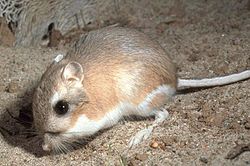Geomorpha
| Geomyoid rodents Temporal range: Early Eocene - Recent |
|
|---|---|
 |
|
| Kangaroo rat | |
| Scientific classification | |
| Kingdom: | Animalia |
| Phylum: | Chordata |
| Class: | Mammalia |
| Order: | Rodentia |
| Suborder: | Castorimorpha |
| Family: |
Geomyoidea Bonaparte, 1845 |
| Families | |
|
†Eomyidae |
|
†Eomyidae
†Heliscomyidae
†Florentiamyidae
Geomyidae
Heteromyidae
Geomyoidea is a superfamily of rodent that contains the pocket gophers (Geomyidae), the kangaroo rats and mice (Heteromyidae), and their fossil relatives.
Although dissimilar in overall appearance, gophers have been united with kangaroo rats into a common superfamily for a considerable time. The superfamily Geomyoidea is among the few superfamilial relationships in rodents that is not subject to much controversy. Overall morphology, the fossil record, molecular analyses, and biogeography all support this relationship.
Geomyoids are most noticeably characterized by the position of the infraorbital canal. Unlike all other rodents who have the opening of the infraorbital canal facing forward, geomyoids have an infraorbital canal that faces to the side. Instead of passing through the zygoma, the infraorbital canal of geomyoids has moved to the side of the snout. This condition is so pronounced and the snout so narrow in heteromyids that the infraorbital canals from either side connect. Essentially, if the skull of a heteromyid is viewed from the side, the viewer can see directly through it.
Modern geomyoids are mostly restricted to North America, but some representatives have extended their range into South America since the Great American Interchange. Fossil taxa are known from throughout Laurasia.
Geomyoids have been considered to be either sciuromorphous or myomorphous depending on the authority. The masseter muscle does not pass through the infraorbital canal; it cannot due to the position of the canal. Some authorities consider the geomyoids related to squirrels, beavers, and mountain beavers on this basis.
...
Wikipedia
